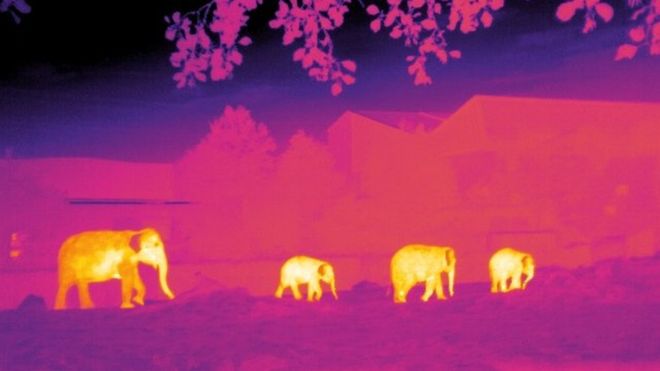The team of scientists is developing a system to automatically identify animals using a camera that has been mounted on a drone.
It is able to identify them from the heat they give off, even when vegetation is in the way.
Details of the system were presented at the annual meeting of the European Astronomical Society in Liverpool, UK.
The idea was developed by Serge Wich, a conservationist at Liverpool John Moores University, and Dr Steve Longmore, an astrophysicist at the same university. He says that the system has the potential to greatly improve the accuracy of monitoring endangered species and so help save endangered species.
"Conservation is not only about the numbers of animals but also about political will and local community supporting conservation. But better data always helps to move good arguments forward. Solid data on what is happening to animal populations is the foundation of all conservation efforts".
Currently, conservationists estimate numbers of endangered species by physically counting them or the signs they leave.
This is an inexact science, as the animals can be in areas inaccessible to observers. Further problems can arise if species have migrated to another area since the previous census. Signs of their presence, such as abandoned nests, rely on assumptions such as the number of animals that share the nest and the frequency with which the species build and abandon their nests.
The process is time consuming, expensive and inaccurate. So Dr Wich developed a system to monitor them using infrared cameras mounted on drones.
Trials at Chester Zoo and Knowsley Safari Park showed that the system could pick up animals on the ground from the heat they gave off, even through tree cover.
But the problem was that they couldn't always identify the species - especially when they were far away. Dr Wich needed a system that could identify different species from their heat signatures.
He explained his problem to his neighbour, Dr Steve Longmore, while chatting over the fence. The neighbour was an astronomer and he explained that he knew someone who identified the size and age of far away stars from their heat signatures.
"I collaborated with quite a few people during my career but astrophysicists were not on my list of potential collaborators," Dr Wich told BBC News.
"But here we are. It shows how the serendipity of how science works."
Dr Wich worked with astrophysicist Dr Claire Burke, also at Liverpool John Moores University. She told BBC News that her work in identifying the most massive galaxies in the Universe from the light they emit helped her devise software that could identify different types of animal from the pattern of the heat they give off.
Each species, she said, has distinct warmer and colder areas that are unique.
"When we look at animals in the thermal infrared, we're looking at their body heat and they glow in the footage. That glow is very similar to the way that stars and galaxies in space glow," Dr Burke explained.
"So we can apply techniques and software used in astronomy for decades to automatically detect and measure this glow".
The system can also give information about the health of animals. If an animal is injured then that part of the animal's body will be glowing brighter than the rest. Similarly, diseased animals also have a different heat profile, according to Dr Burke.
"The real advantage this gives you is that if you know how many animals you have and where they are and what kind of health they are in, then you can you can formulate a good conservation strategy for looking after them," she said.
"And if you can track them as well, then you can tell what they need to survive and thrive and this helps us. If, for example, we needed to relocate animal because its habitat was being destroyed then you would know better what it needed to be relocated to."
More about: science















































